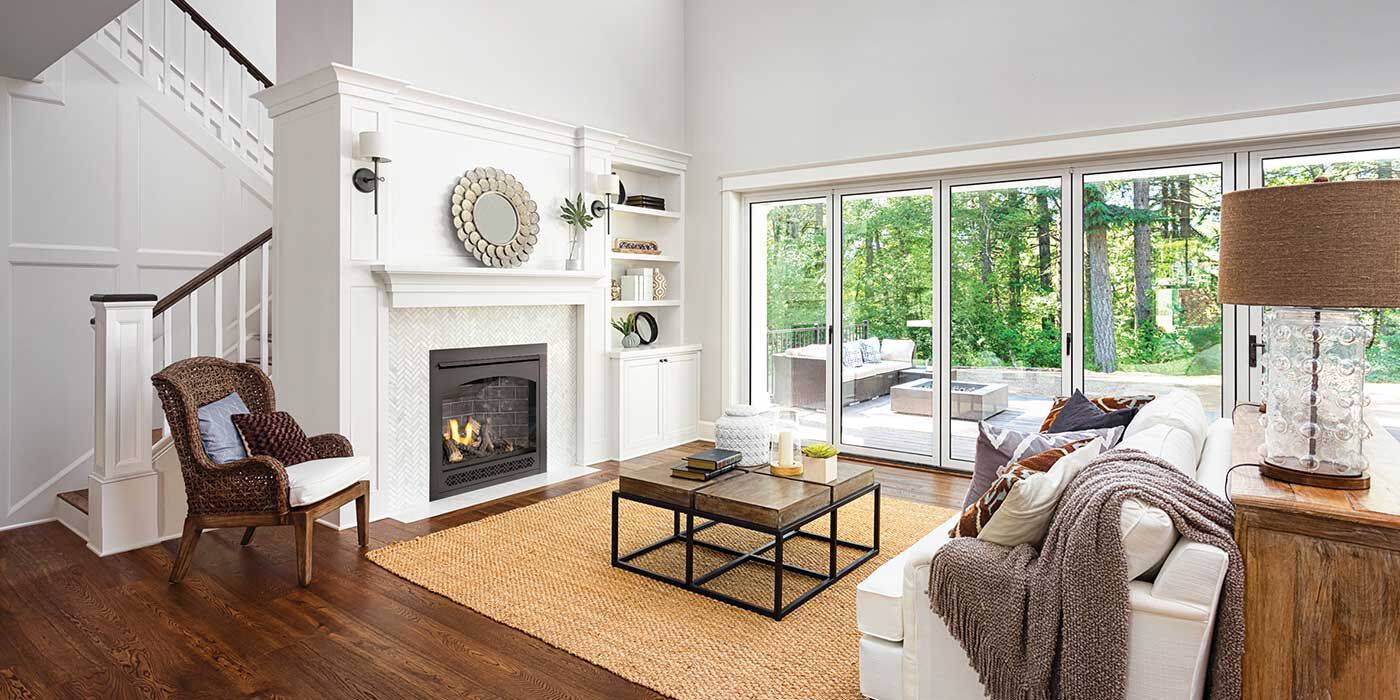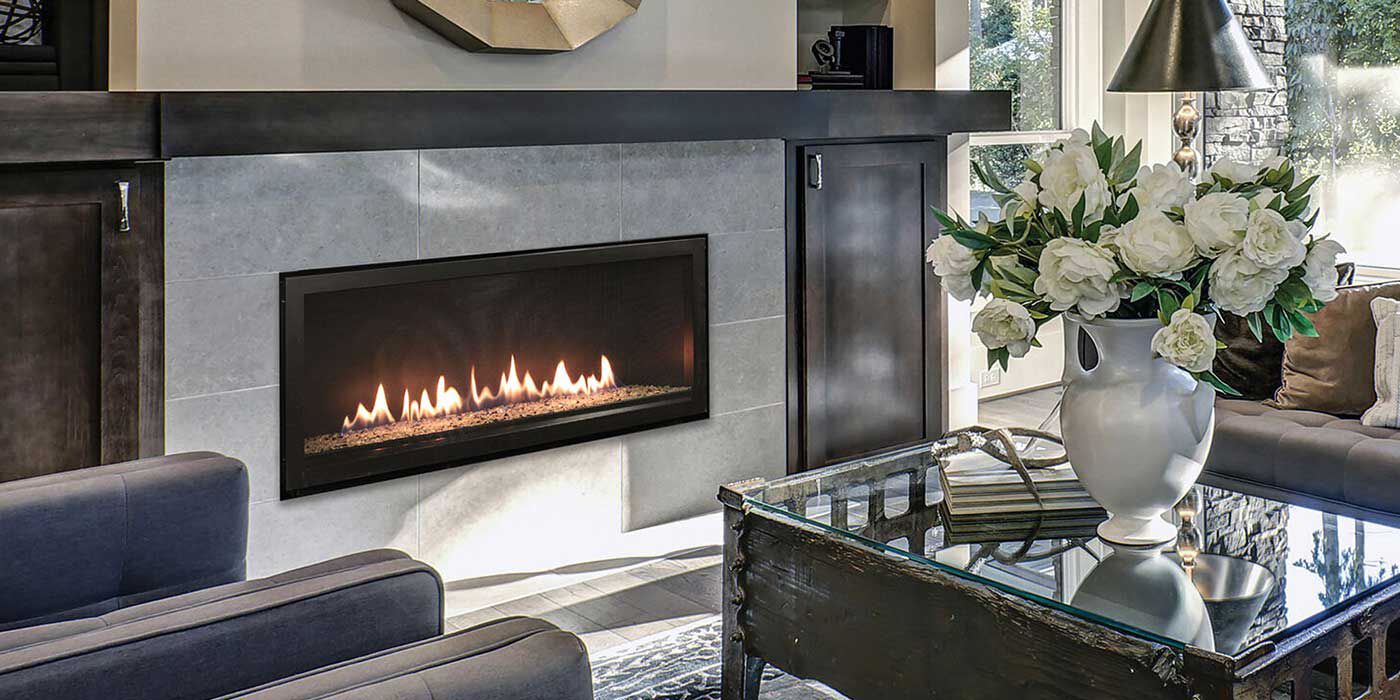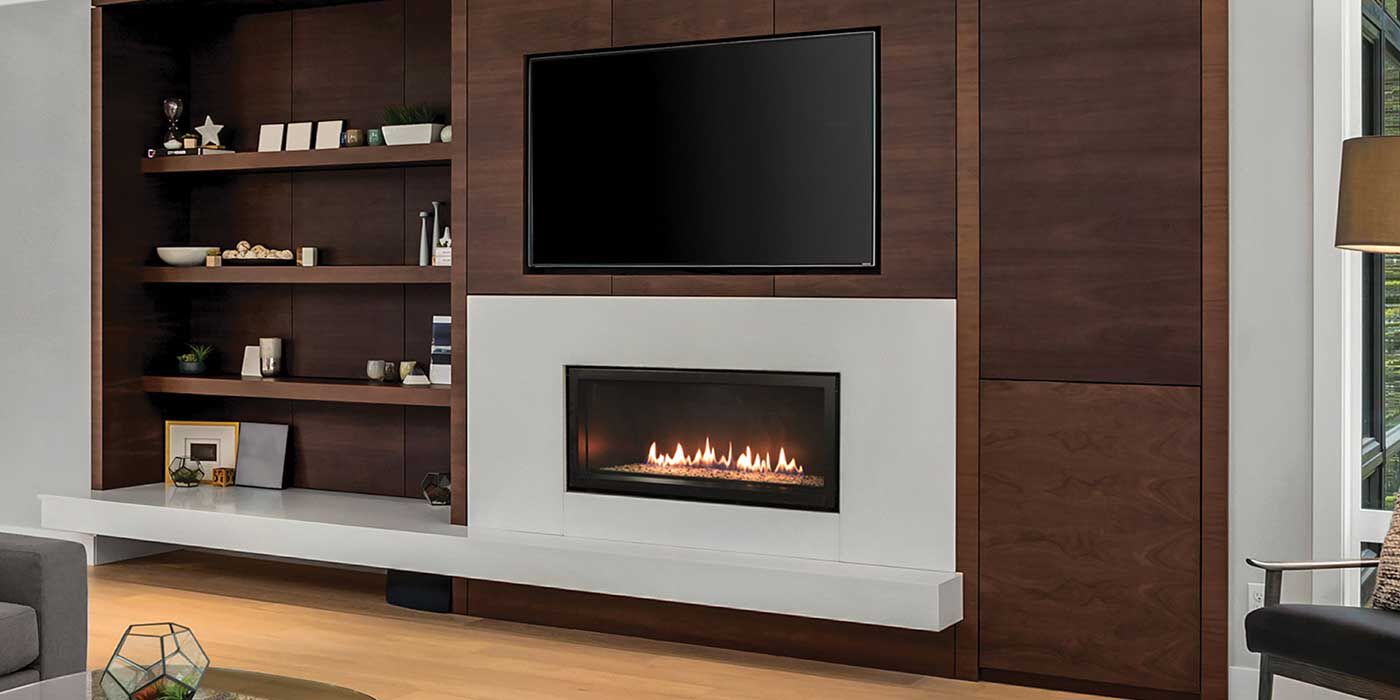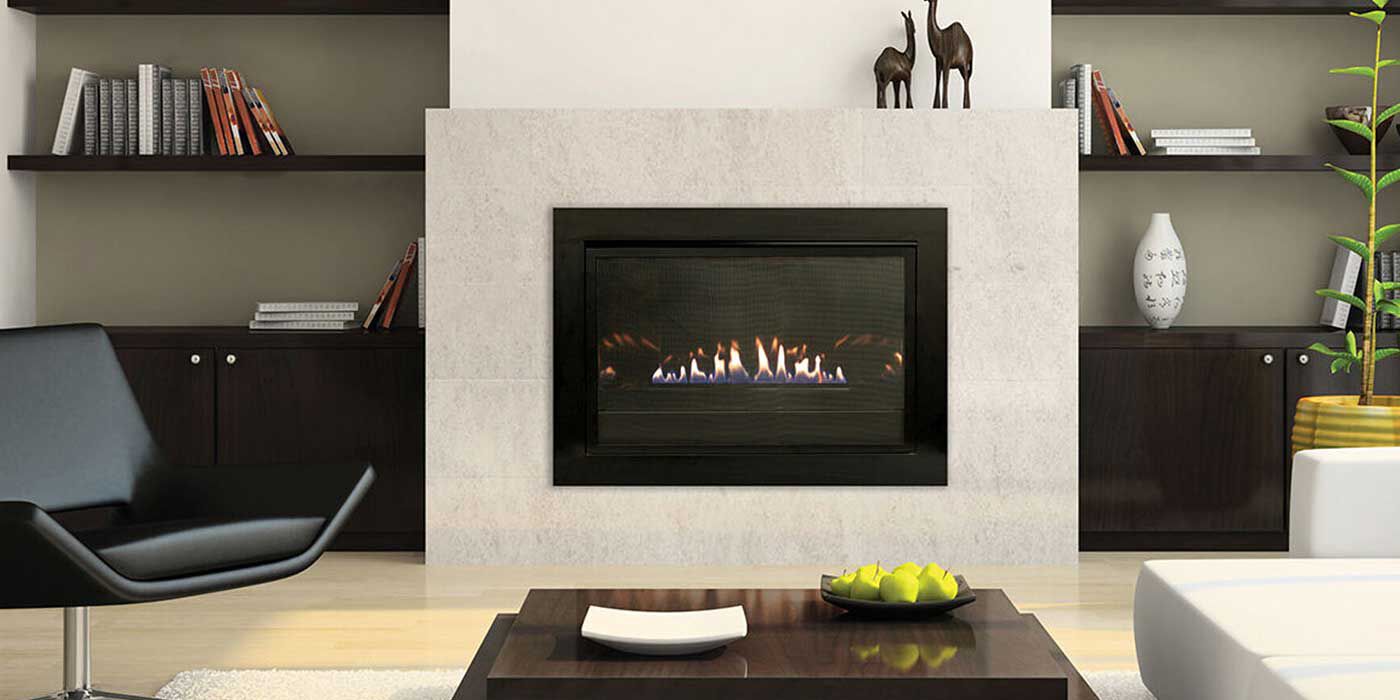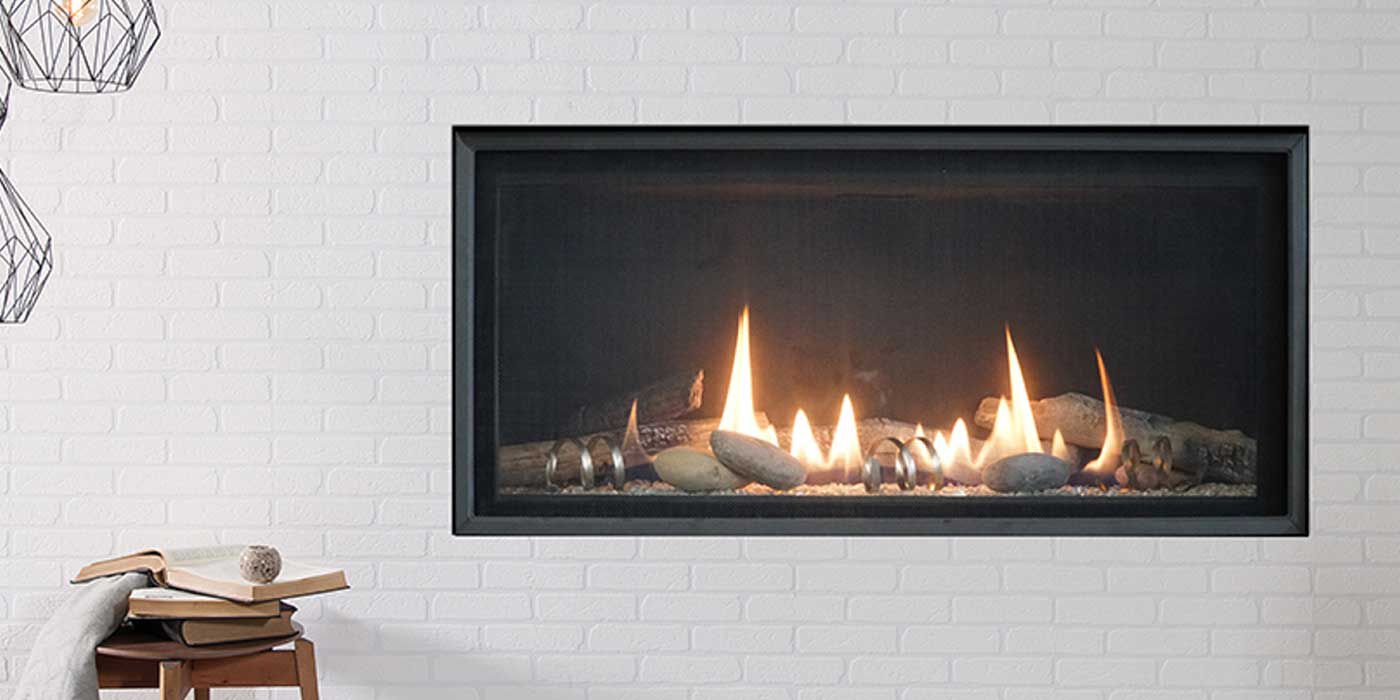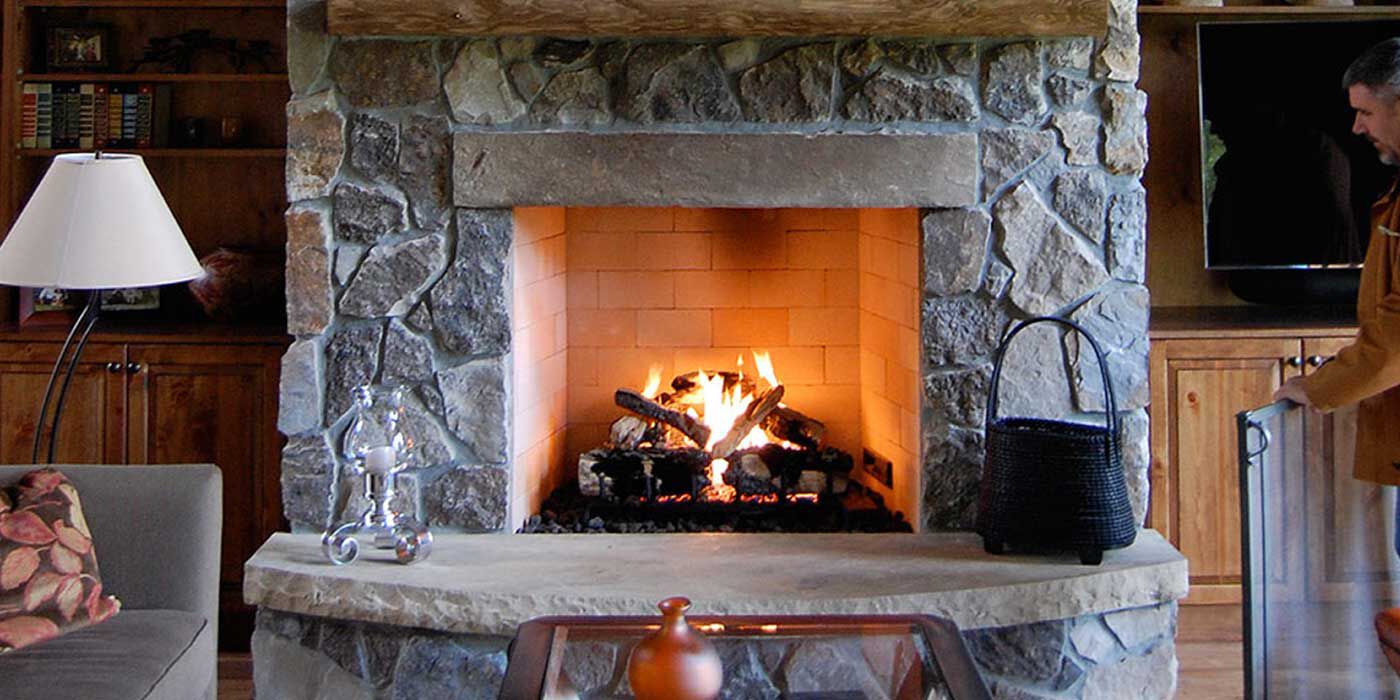By: Tiffany Kurilla, NFI Certified Master Hearth Professional
Last Updated: April 21, 2025
A gas fireplace is one of the best ways to bring warmth and ambiance into your home. With the press of a button or flip of a switch, they create beautiful, cozy flames, elevating the vibe of every occasion, from hosting guests to relaxing after a long day.
Gas fireplaces offer a blend of convenience, efficiency, and design flexibility. Unlike wood burning fireplaces, gas models don’t require stacking logs, sweeping ashes, or constant tending. They’re also clean burning, so you won’t have to worry about emissions.
There are three types of gas fireplaces to choose from, including Direct Vent, Ventless (also called Vent-Free or Unvented), and B-Vent.
Direct Vent fireplaces are the most popular option, while Ventless fireplaces offer more flexible installation. B-Vent models are the least popular, but they provide the most realistic flames.
Whether you're building new, remodeling, or just looking for a cozy upgrade, this guide will walk you through everything you need to know to find the perfect fireplace design.
In This Article
Direct Vent Gas Fireplaces
- What is a Direct Vent Fireplace?
- How do Direct Vent fireplaces work?
- Are Direct Vent fireplaces safe?
- Where can I install a Direct Vent fireplace?
- What Direct Vent fireplace styles are available?
- Shop our most popular Direct Vent fireplaces
Ventless Gas Fireplaces
- What is a Ventless fireplace?
- How do Ventless fireplaces work?
- Are Ventless fireplaces safe?
- Where can I install a Ventless fireplace?
- What Ventless fireplace styles are available?
- Shop our most popular Ventless fireplaces
B-Vent Gas Fireplaces
- What is a B-Vent fireplace?
- How do B-Vent fireplaces work?
- Are B-Vent fireplaces safe?
- Where can I install a B-Vent fireplace?
- What B-Vent fireplace styles are available?
- Shop our most popular B-Vent fireplaces
Gas Fireplace Features
- How do I ignite the flames?
- How do I control the fire and heat?
- Can I customize my gas fireplace?
- Can I increase the heat output?
- How do I make installation more flexible?
- How do I take care of my gas fireplace?
Gas Fireplace FAQs
Direct Vent Fireplaces
What Is a Direct Vent Fireplace?
Direct Vent fireplaces are safe and efficient alternatives to traditional gas and wood burning fireplaces.
You won’t need a chimney for your Direct Vent fireplace. They use a completely sealed venting system to work. The system pulls fresh air into the firebox (from outside) for the fire, and exhausts combustion gases out of your home.
Direct Vent fireplaces also have glass fronts and safety barrier screens. Some models come with standard, tempered glass, while others offer heat-retaining ceramic glass as an upgrade.
With a sealed venting system, you’ll get beautiful flames and plenty of warmth, while maintaining your indoor air quality.
How Do Direct Vent Fireplaces Work?
Direct Vent fireplaces can have a co-linear or co-axial venting system.
Co-linear Venting Systems
In a co-linear venting system, two pipes run parallel to each other. One of the pipes pulls in fresh air for the fire, while the other pipe exhausts combustion byproducts.
Co-linear systems are most often used with Direct Vent fireplace inserts in masonry chimneys.
Pro Tip:
Co-linear venting systems need to be terminated vertically. This may affect the final placement of your gas fireplace.
Co-axial Venting Systems
Co-axial venting systems consist of a pipe within a pipe, separated by 1 inch or more. The outer pipe draws in fresh outside air for combustion, while the inner pipe expels combustion byproducts.
As hot air exits your fireplace, the co-axial system pulls cool air in from outside. This creates a consistent flow of heat, known as a convection loop.
Pro Tip:
For co-axial systems, your Direct Vent fireplace can have a flue outlet on the top or rear of the firebox, creating more installation flexibility.
Are Direct Vent Fireplaces Safe?
When installed properly by a licensed professional, Direct Vent fireplaces are one of the safest options available.
Here are a few safety tips:
🔥 While your indoor air quality isn’t affected, we recommend installing carbon monoxide detectors in your home.
🔥 Have your gas fireplace serviced and cleaned at least once a year to make sure it stays safe and efficient.
🔥 Don’t run your Direct Vent fireplace without the safety barrier or glass in place. Without the glass, your fireplace could release combustion gases into your living space.
Where Can You Install a Direct Vent Fireplace?
With the correct venting system, you can install your Direct Vent fireplace in practically any room of the house.
However, each city and state will have specific code requirements. Make sure you check your local fire and building codes before installing your fireplace.
What Direct Vent Fireplace Styles Are Available?
Direct Vent fireplaces are available in linear, traditional, single-sided, multi-sided (peninsula), see-through, and corner styles.
Need some inspiration? Check out our best-selling Direct Vent fireplaces here!
Shop Our Most Popular Direct Vent Fireplaces
Ventless Fireplaces
What Is a Ventless Fireplace?
Ventless (Vent-Free/Unvented) gas fireplaces are freestanding units that don’t require a chimney or venting system.
Without a chimney for hot air to escape through, all the heat produced stays inside your home. This makes Ventless fireplaces extremely efficient and economical heating sources.
While the heat output is great, the overall look of the flame display is less intense than Direct Vent and B-Vent units. For this reason, Ventless fireplaces are primarily sold as heaters, rather than decorative appliances.
How Do Ventless Fireplaces Work?
Ventless gas fireplaces function on a closed-loop system of indoor air. The system pulls cool room air into the firebox to complete combustion.
The air cycles around the firebox before flowing back out into the room as heat.
Ventless gas fireplaces burn at nearly 100% efficiency, leaving little to no gases behind after combustion. Typically, they only release a small amount of water vapor and carbon dioxide. Any dangerous gases, like carbon monoxide, will be minimal and within safe limits.
As Ventless fireplaces burn oxygen, they produce moisture in the form of water vapor. You may notice some condensation on your windows or surfaces throughout the room. This is especially true with Propane gas.
Are Ventless Fireplaces Safe?
Overall, Ventless fireplaces are safe to install in any home.
The main concern is that your Ventless fireplace must always function optimally, or it will release harmful gases into your space.
Here are a few safety tips:
🔥 Research your local building, city, and state codes to see if there are any installation restrictions you need to follow. Some states, like California, have outlawed Ventless fireplaces for indoor use altogether, while states have strict installation requirements.
🔥 Make sure your Ventless fireplace has a built-in oxygen depletion sensor (ODS) on the ignition pilot. The ODS monitors the oxygen level in the room. If the oxygen supply dips below an 18% threshold, the ODS automatically shuts off your gas supply.
🔥 To remedy excessive moisture, crack a window open when you run your Ventless fireplace. You can also install a hygrometer to keep track of the humidity levels in your home.
🔥 We recommend using a Ventless fireplace for one hour at a time and four hours max in one day to make sure your oxygen and humidity levels remain balanced.
Where Can You Install a Ventless Fireplace?
Ventless fireplaces offer more flexibility with installation because they don’t require a chimney. However, they do have more restrictions for location, room size, media options, and elevation.
Without a chimney or venting, air quality and oxygen depletion are both major concerns. You cannot safely install a Ventless fireplace in a small or compact room where oxygen supply is limited.
To preserve an adequate supply of oxygen, Ventless fireplaces are limited to 40,000 BTUs of heat per hour. For bathrooms and bedroom installations, they're limited to 6,000-10,000 BTUs, regardless of room size.
Ventless fireplace manufacturers calibrate each model to burn a specific air to gas ratio, ensuring minimal byproducts after combustion.
If you live in an area with high elevation, like Colorado, you may need to have the gas outlet on your fireplace adjusted to offset the higher altitude and thinner air quality. You can have any adjustments made by the manufacturer when you purchase your fireplace or by a licensed gas professional during installation.
What Ventless Fireplace Styles Are Available?
Ventless fireplaces are available in linear, traditional, single-sided, multi-sided (peninsula), see-through, and corner styles.
Need some inspiration? Check out our best-selling Ventless fireplaces here!
Shop Our Most Popular Ventless Gas Fireplaces
B-Vent Fireplaces
What Is a B-Vent Fireplace?
B-Vent fireplaces, also known as Natural Vent, are the least popular gas fireplace option on the market.
While they're more affordable than Direct Vent and Ventless fireplaces, they are inefficient and more difficult to install.
How Do B-Vent Fireplaces Work?
B-Vent fireplaces feature an open-front design and operate similarly to traditional wood fireplaces. They pull fresh air into the firebox from inside your home for combustion and use a vertical pipe to carry away exhaust and fumes.
Most of the heat produced by the fire will escape through the vents. That's why B-Vent fireplaces are often used for aesthetic purposes, rather than supplemental heat.
B-Vent fireplaces create a natural movement of air through insulated pipes. The airspace between the inner and outer pipe provides insulation to prevent heat loss, while the inner pipe warms up quickly. Once the pipe is warm, hot flue gases can exit through the top of the pipe with ease.
Are B-Vent Fireplaces Safe?
B-Vent fireplaces are safe. With a vertical venting system to exhaust combustion byproducts, dangerous gases won't build up in your home.
Some models also feature a sensor that shuts off your fireplace if a downdraft occurs.
Here are a few safety tips:
🔥 Install carbon monoxide detectors near your B-Vent fireplace.
🔥 B-vent fireplaces rely on proper draft through the vertical vent pipe. Never block or modify the venting system.
🔥 Have a certified technician check for vent blockages, gas leaks, or wear and tear at least once a year. Any signs of soot on the walls or odd smells may point to poor combustion or vent issues — get it checked immediately.
Where Can You Install a B-Vent Fireplace?
B-Vent fireplace installation is slightly more limited than Direct Vent or Ventless gas fireplaces.
Like a masonry chimney, the venting for B-Vent fireplaces must terminate vertically through the roof of your house. This limits the location of installation to areas where a vertical pipe can run straight up to the roof.
What B-Vent Fireplace Styles Are Available?
B-Vent fireplaces are available as inserts and custom masonry fireboxes. With a custom firebox, you'll be able to choose from a variety of designs and finishes to match your home decor.
Shop Our Most Popular B-Vent Fireplaces
Gas Fireplace Features
What Ignition Systems are Available?
Two different ignition systems are available for gas fireplaces — intermittent pilot ignition (IPI) and continuous pilot ignition (CPI). For both systems, you can light the pilot with a switch on the fireplace.
Once the flames ignite, a flame-sensing thermocouple registers the heat and sends an electrical current to the gas valve. The gas valve opens, sending a constant stream of fuel to the pilot light.
If the flame ever goes out, the thermocouple will cool down, stopping the electrical current, and shutting off the gas supply.
With an IPI, the pilot stays lit if the fireplace is on. Once you turn your fireplace off, the pilot light will go out.
With a CPI, the pilot is continuous, meaning it will always stay lit unless there is an issue with the gas supply.
Most gas fireplaces also feature a battery backup, so you can turn your fireplace on during a power outage.
Pro Tip:
IPI’s are best for warm-weather climates, or areas where you won’t be using your fireplace every day. They will save you gas, however, the initial start-up will take between 15-20 seconds each time you turn your fireplace on. CPI’s are best for cold-weather climates, or areas with long winters where you’ll be using your fireplace often.
How Can You Control Your Gas Fireplace?
Most gas fireplaces come with a hand-held remote control or a wall switch. You can choose a standard, On/Off remote for basic functionality, or upgrade to a full-feature remote.
With a multi-function remote, you can adjust the ignition, blower speed, heat output, flame height, thermostat, and timer.
Some modern gas fireplaces can even pair with a smart home system. Integrated Bluetooth controls allow you to connect your fireplace to a smart device, offering the ultimate, user-friendly experience.
Can You Customize Your Gas Fireplace?
Most gas fireplace manufacturers give you the option to choose the surround (trim) and media bed.
Surrounds come in various widths, colors, textures, and materials, making it easy to match your home’s décor.
Many homeowners add a set of gas logs to their media beds for an authentic-looking display. Other media options include sparkling fire glass, rustic river rocks, and contemporary fireballs.
How to Get the Most Heat Possible
A fireplace blower is a type of fan that helps to blow more heat from the fireplace out into the room.
Blowers don’t make gas fireplaces more efficient, but they do help to increase the overall heat output. Like a fan, blowers are not silent and will make a whirring noise while in use.
How to Make Installation More Flexible
Power venting can make your fireplace a lot more efficient, especially in large, commercial settings. Think condos, high-rise buildings, and tall apartment complexes where traditional venting won’t work.
In a power venting system, a fan is installed where the system begins or where it ends. The fan pushes and pulls the exhaust through the venting and out of the building.
With a power venting system, you can install your fireplace in areas where venting must run down, across, and up to the roof.
All power venting solutions are specific to the manufacturer.
How to Take Care of Your Gas Fireplace
Cleaners are available to keep your gas fireplace looking like new. You can use a glass and hearth cleaner to remove any build-up from the inside of the ceramic glass front.
To remove soot and residue from your gas logs or burning media, simply using plain water and a soft cloth will do the trick. Harsh cleaning agents can cause gas logs to become brittle over time, making them more susceptible to breakage.
For a more in-depth look at how to care for your gas fireplace, check out our step-by-step maintenance guide.
People Also Ask
Can I convert my wood burning fireplace to gas?
Yes, you can convert your existing fireplace with a gas fireplace insert or a gas log set.
If you’re not sure which product to go with, one of our licensed professionals can help you determine the best choice for your current setup.
Do I need a chimney for my gas fireplace?
Some gas fireplaces require a vent or chimney to expel combustion gases, depending on the model. However, many modern gas fireplaces are Ventless and do not need a chimney.
Always check the manufacturer's specifications and your local building codes.
Do I need a Natural Gas line for my gas fireplace?
Not all gas fireplaces use Natural Gas. Most of the designs we carry offer both Natural Gas and Propane configurations.
However, the fuel types are not interchangeable. You’ll need a conversion kit and professional service, since the burners and gas regulators are different for Natural Gas and Propane fireplaces.
How much does it cost to install a gas fireplace?
Installation costs vary based on the type of fireplace, venting requirements, and labor. On average, expenses can range from $2,000 to $5,000 or more.
Can I install a gas fireplace myself?
Due to the complexities of gas lines and venting, we always recommend having a licensed professional handle the installation. This ensures safety and compliance with local codes.
We're Here to Help
Need help choosing the best gas fireplace for your space? Call our NFI certified experts at 800.919.1904.
More Resources
What's so great about gas logs? Check out the top six advantages of gas logs to find out!
Make your patio space more luxurious with an outdoor fireplace! Check out our best-selling gas models to find some inspiration.
Electric fireplaces are another incredible option for any home, offering year-round ambiance with or without the extra heat. Explore the benefits of going electric.
 |
Tiffany Kurilla, Technical Sales Representative, has five years of experience at Woodland Direct. As an NFI-Certified Master Hearth Professional, she’s recognized for her deep knowledge of fireplace products and safety standards. Tiffany’s dedication and mastery earned her the title of Woodland’s top sales representative in 2021 and 2022. Outside of work, Tiffany is an avid traveler, exploring national and international destinations. Her favorite spot to visit? The Happiest Place on Earth — Disney World! Call Tiffany or one of our experts in fire at 800.919.1904. |
